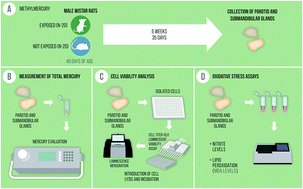当前位置:
X-MOL 学术
›
Metallomics
›
论文详情
Our official English website, www.x-mol.net, welcomes your
feedback! (Note: you will need to create a separate account there.)
Chronic intoxication by methylmercury leads to oxidative damage and cell death in salivary glands of rats
Metallomics ( IF 2.9 ) Pub Date : 2017-10-10 00:00:00 , DOI: 10.1039/c7mt00168a Paulo Mecenas Alves Farias-Junior 1, 2, 3, 4, 5 , Francisco Bruno Teixeira 1, 2, 3, 4, 5 , Nathalia Carolina Fernandes Fagundes 1, 2, 3, 4, 5 , Giza Hellen Nonato Miranda 1, 2, 3, 4, 5 , Leonardo Oliveira Bittencourt 1, 2, 3, 4, 5 , Ricardo Sousa de Oliveira Paraense 2, 3, 4, 5, 6 , Márcia Cristina Freitas Silva 1, 2, 3, 4, 5 , Fernanda do Espírito Santo Sagica 5, 7, 8, 9 , Edivaldo Herculano de Oliveira 5, 7, 8, 9, 10 , Maria Elena Crespo-López 2, 3, 4, 5, 6 , Rafael Rodrigues Lima 1, 2, 3, 4, 5
Metallomics ( IF 2.9 ) Pub Date : 2017-10-10 00:00:00 , DOI: 10.1039/c7mt00168a Paulo Mecenas Alves Farias-Junior 1, 2, 3, 4, 5 , Francisco Bruno Teixeira 1, 2, 3, 4, 5 , Nathalia Carolina Fernandes Fagundes 1, 2, 3, 4, 5 , Giza Hellen Nonato Miranda 1, 2, 3, 4, 5 , Leonardo Oliveira Bittencourt 1, 2, 3, 4, 5 , Ricardo Sousa de Oliveira Paraense 2, 3, 4, 5, 6 , Márcia Cristina Freitas Silva 1, 2, 3, 4, 5 , Fernanda do Espírito Santo Sagica 5, 7, 8, 9 , Edivaldo Herculano de Oliveira 5, 7, 8, 9, 10 , Maria Elena Crespo-López 2, 3, 4, 5, 6 , Rafael Rodrigues Lima 1, 2, 3, 4, 5
Affiliation

|
Methylmercury (MeHg) is one of the most toxic species of mercury, causing several systemic damages; however, its effect on the salivary glands has rarely been explored to date. This study was aimed at analyzing the mercury deposit, oxidative stress markers, and cell viability in parotid and submandibular rat salivary glands after chronic methylmercury intoxication. Herein, forty male Wistar rats (40 days old) were used in the experiment. The animals of the experimental group were intoxicated by intragastric gavage with MeHg at a dose of 0.04 mg per kg body weight per day for 35 days, whereas the control group received only corn oil, a diluent. After the period of intoxication, the glands were obtained for evaluation of total mercury deposit, cell viability, and the malondialdehyde (MDA) and the nitrite levels. Our results indicated mercury deposits in salivary glands, with a decrease in cell viability, higher levels of MDA in both glands of intoxicated animals, and a higher concentration of nitrite only in the submandibular gland of the mercury group. Thus, the intoxication by MeHg was able to generate deposits and oxidative stress in salivary glands that resulted in a decrease in cell viability in both types of glands.
中文翻译:

甲基汞引起的慢性中毒导致大鼠唾液腺的氧化损伤和细胞死亡
甲基汞(MeHg)是汞的毒性最高的物质之一,会引起多种系统性损害;然而,迄今为止,它对唾液腺的作用很少被探索。这项研究旨在分析慢性甲基汞中毒后腮腺和下颌大鼠唾液腺中的汞沉积,氧化应激标记和细胞活力。在此,将40只雄性Wistar大鼠(40天大)用于实验。实验组的动物每天以每公斤体重0.04 mg的剂量用MeHg灌胃35天,而对照组则只接受玉米油(一种稀释剂)。在中毒一段时间后,获得腺体以评估总汞沉积,细胞活力以及丙二醛(MDA)和亚硝酸盐水平。我们的结果表明,唾液腺中存在汞沉积,细胞活力降低,中毒动物的两个腺体中的MDA含量较高,仅在汞组的颌下腺中存在较高的亚硝酸盐浓度。因此,MeHg引起的中毒能够在唾液腺中产生沉积物和氧化应激,从而导致两种腺体中细胞活力的下降。
更新日期:2017-10-10
中文翻译:

甲基汞引起的慢性中毒导致大鼠唾液腺的氧化损伤和细胞死亡
甲基汞(MeHg)是汞的毒性最高的物质之一,会引起多种系统性损害;然而,迄今为止,它对唾液腺的作用很少被探索。这项研究旨在分析慢性甲基汞中毒后腮腺和下颌大鼠唾液腺中的汞沉积,氧化应激标记和细胞活力。在此,将40只雄性Wistar大鼠(40天大)用于实验。实验组的动物每天以每公斤体重0.04 mg的剂量用MeHg灌胃35天,而对照组则只接受玉米油(一种稀释剂)。在中毒一段时间后,获得腺体以评估总汞沉积,细胞活力以及丙二醛(MDA)和亚硝酸盐水平。我们的结果表明,唾液腺中存在汞沉积,细胞活力降低,中毒动物的两个腺体中的MDA含量较高,仅在汞组的颌下腺中存在较高的亚硝酸盐浓度。因此,MeHg引起的中毒能够在唾液腺中产生沉积物和氧化应激,从而导致两种腺体中细胞活力的下降。











































 京公网安备 11010802027423号
京公网安备 11010802027423号